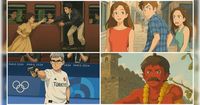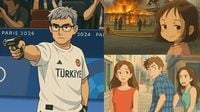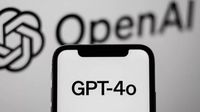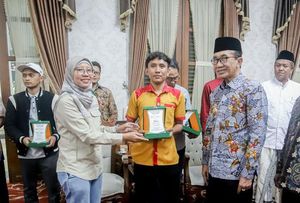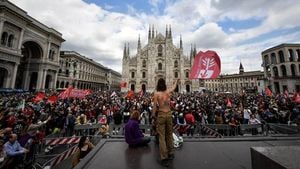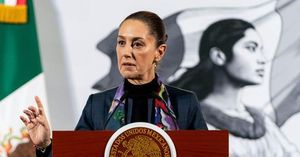OpenAI has taken a significant leap in artificial intelligence creativity with the introduction of native image generation in its GPT-4o model. Announced on March 25, 2025, this new feature allows users to generate a wide array of images—including infographics, comic strips, memes, street signs, and user interfaces—entirely from text prompts. One of the standout applications is the ability to transform ordinary images into artwork inspired by Studio Ghibli, the acclaimed Japanese animation studio known for its enchanting storytelling and lush visuals.
Dubbed "Images in ChatGPT," this feature has quickly taken social media by storm, with users flooding platforms like X with their AI-generated Ghibli-style creations. From serene countryside scenes to whimsical urban landscapes, the trend has resonated particularly well with Studio Ghibli’s dedicated fanbase, who see it as a fusion of modern technology and timeless animation artistry.
Even OpenAI CEO Sam Altman has joined in on the excitement. He changed his profile picture on X to a Ghibli-style portrait of himself and humorously remarked, "Be me. Grind for a decade trying to help make superintelligence to cure cancer or whatever. Mostly no one cares for the first 7.5 years, then for 2.5 years everyone hates you for everything. Wake up one day to hundreds of messages: ‘Look, I made you into a twink Ghibli-style haha.’" This lighthearted comment underscores the widespread appeal and playful nature of the new feature.
Unlike previous AI-generated art that relied on external tools like OpenAI’s DALL-E, GPT-4o’s native image generation integrates image creation directly within the model. This means that users can effortlessly craft visuals by specifying details such as aspect ratio, color schemes using hex codes, or even transparent backgrounds—all through simple text prompts. As users continue to experiment with this innovative feature, it’s evident that OpenAI has unlocked a new era of AI-driven artistic expression.
On the same day of the announcement, OpenAI emphasized that image generation should be a primary capability of language models. "At OpenAI, we have long believed image generation should be a primary capability of our language models," the company stated. The system has been trained on the joint distribution of online images and text, allowing it to understand how images relate to language and to each other, thereby creating a more cohesive visual understanding.
While previous models excelled at creating surreal or artistic images, GPT-4o aims to make image generation a functional tool for everyday communication needs. The model's text rendering capabilities are particularly impressive, allowing it to accurately create street signs, menus, invitations, and other text-heavy imagery that previous models struggled with. This makes it an invaluable resource for design mockups, educational materials, and business communications.
One of the key advantages of having image generation built directly into GPT-4o is its ability to refine images through natural conversation. The model maintains consistency throughout iterations, allowing users to gradually refine their creations without losing context. This is especially beneficial for design processes, story illustrations, or character development in games and narratives where visual continuity is crucial.
OpenAI has also ensured that the model can handle complex prompts effectively, managing 10-20 different objects with better control over their traits and relationships. This improvement is a significant step forward, as traditional models often struggled with more than five to eight objects.
However, the rollout of GPT-4o’s image generation feature to free users has been delayed due to the tool's unexpected popularity. Sam Altman acknowledged this in a post, stating, "Images in ChatGPT are wayyyy more popular than we expected (and we had pretty high expectations). Rollout to our free tier is unfortunately going to be delayed for a while." Currently, the image generation feature is available to Plus, Pro, Team, and Free users, albeit with limited access for the latter group.
In addition to its Ghibli-style transformations, the versatile image generation tool lets users explore creativity across various artistic domains, including styles reminiscent of South Park, Minecraft, Lego, watercolor, marionette, and rubber hose animation. This flexibility offers a vast landscape for artistic exploration and creative design applications, particularly in producing infographics, product mockups, logos, posters, and other visual advertising campaigns.
Despite the excitement surrounding this new feature, ethical considerations regarding AI-generated content remain at the forefront. OpenAI has implemented measures to allow artists to opt-out of having their work included in future training datasets and has confirmed that all images will include metadata from the Coalition for Content Provenance and Authenticity (C2PA) to indicate their AI-generated origin. Additionally, the company has internal tools to track images created by its models, ensuring transparency and accountability.
As the world of AI continues to evolve, OpenAI’s advancements in image generation showcase how technology can enhance creativity and communication. With the ability to generate high-quality images and refine them through conversational interaction, GPT-4o sets a new standard for what AI can achieve in the realm of artistic expression.
While Studio Ghibli has not commented on the use of its distinctive art style by OpenAI, it is worth noting that Hayao Miyazaki, one of the studio's founders, has previously criticized AI-generated animation. In a 2016 interview, he described it as "an insult to life itself," expressing his disapproval of the technology. As users continue to create Ghibli-inspired images, the question remains: how will traditional artists respond to the growing influence of AI in creative fields?
